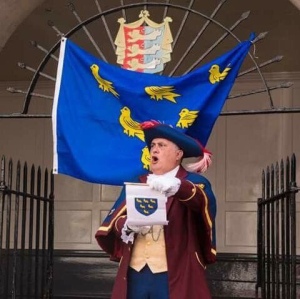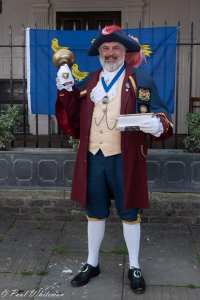Sussex Day is the the 16th of June, the feast day of local saint, Richard. Saint Richard

was born in the town of Wyche (modern Droitwich, Worcestershire) in 1197. A member of a gentry family, he initially farmed his elder brother’s estates who, according to legend, offered him land and a marriage arrangement but Richard refused these, preferring a life of study and the church. He was educated at the University of Oxford and soon began to teach there, proceeding to the University of Paris and then the University of Bologna. In 1235, upon his return to England, he was elected chancellor of Oxford University and in about 1237, became chancellor of the diocese of Canterbury under Archbishop Edmund Rich.
Some time after Edmund’s death in 1240, Richard became vicar of Deal then in 1244 he was elected Bishop of Chichester, although King Henry III

favoured Robert Passelewe over him. Archbishop of Canterbury, Boniface

refused to confirm Passelew, so both sides appealed to the Pope. The king confiscated the See’s properties and revenues but Pope Innocent IV confirmed Richard’s election and consecrated him bishop at Lyons in March 1245. Richard then returned to Chichester but the king refused to restore the See’s properties for two years, and then did so only after being threatened with excommunication. Henry III forbade anyone to house or feed Richard! At first, Richard lived at Tarring, Sussex in the house of his friend Simon, the local parish priest. Richard visited his entire diocese, practically the whole county of Sussex, on foot.
Richard was merciless to usurers, corrupt clergy and priests “who mumbled the Mass”. He was also a stickler for clerical privilege. When the men of Lewes dragged a thief out of sanctuary and hanged him, he made them cut down the corpse and bury it in the sanctuary. On one occasion being short of charity, he commanded that his horse or silver cup be sold and when his steward protested, he replied “Is it that just that you and I should eat and drink out of silver vessels where Christ in His poor is perishing with hunger?”
At midnight on 3 April 1253, Richard died at the Maison Dieu in Dover, Kent. His internal organs were removed and placed in that chapel’s altar. Later his body was carried to Chichester where he was buried, according to his wishes, in the chapel on the north side of the nave, shown below. The chapel that had been dedicated to his patron, St Edmund. His body remained there until it was transferred to its new shrine
in Chichester on 16th June 1276. This date therefore later became the feast day of Saint Richard and has been celebrated in Sussex ever since. On the 16th of June 1276, Chichester was for a few hours the centre of England, when King Edward I, Queen Eleanor, the Archbishop of Canterbury and other bishops, and a great crowd of people came to honour St Richard. He had been Bishop of Chichester for just over eight years but in that brief time became beloved of the people of Sussex. His tomb immediately became a place of pilgrimage and prayer.

Richard was Canonised in 1262. To become a saint, the person in question must have performed miracles in his or her lifetime. The story of one of Richard’s miracles tells that Richard, tired and ill from his labours, was celebrating mass and dropped the chalice containing the consecrated wine. Miraculously, none of the sacramental Blood of Christ spilled! Accordingly, symbolising this miracle, Richard’s coat of arms is a white cross on a red field with a cup in each quarter of the shield, shown here
and seen below in the form of an armorial banner

known as the ‘Cross of St Richard’.
Richard became patron saint of Sussex in the fifteenth century. He is also patron saint of coach drivers. From the 13th to the 16th Century, few Sussex men failed to invoke him in their daily “orisons” or to bequeath something to his shrine, in their wills. From the Order of the Eucharist on St Richard’s Day;
” Father we give you thanks that your glory is revealed in St Richard.
In his life you have given us an example of faithfulness to Christ.
In his holiness we find encouragement and hope.
In our communion with him we share the unity of your Kingdom. ”
The idea of a Sussex Day was that of Ian Steedman of Worthing
 , a day to focus on the county’s rich heritage and culture. Inspired by the practice of the feast days of the patron saints of the home nations, being adopted as national days and with Richard being the patron saint of Sussex and his feast day of June 16th already being celebrated by churches across the county, in 2006 Steedman suggested the idea of celebrating the date as Sussex Day, to Henry Smith, then leader of West Sussex Council. Smith liked the idea and West Sussex Council officially recognised June 16th as ‘Sussex Day’ in 2007. It has since been recognised by all the main local authorities in Sussex and county residents celebrate their county day with marked enthusiasm,
, a day to focus on the county’s rich heritage and culture. Inspired by the practice of the feast days of the patron saints of the home nations, being adopted as national days and with Richard being the patron saint of Sussex and his feast day of June 16th already being celebrated by churches across the county, in 2006 Steedman suggested the idea of celebrating the date as Sussex Day, to Henry Smith, then leader of West Sussex Council. Smith liked the idea and West Sussex Council officially recognised June 16th as ‘Sussex Day’ in 2007. It has since been recognised by all the main local authorities in Sussex and county residents celebrate their county day with marked enthusiasm,

including former mayor of Bexley, Paul Lendon, above and BBC Radio Sussex’s Allison Ferns below

and the flag is much in evidence
, including this approximately thirty feet long example

which flew over Eastbourne bandstand in 2017.
Paul Lendon, seen above in his Sussex flag waistcoat, also participated in the 2020 Bexhill 100 Motoring Club’s classic car cavalcade, in a 1969 Renault Quatrelle, painted in the colours of the county flag!

and Richard Griffiths of the 5% Flying Club is seen here
completing the new Sussex flag decoration of his plane, to mark the county day












